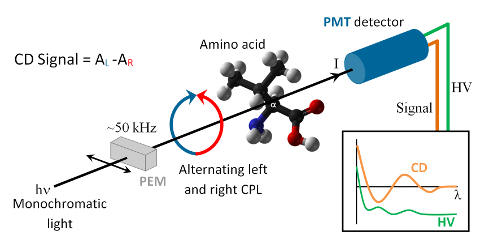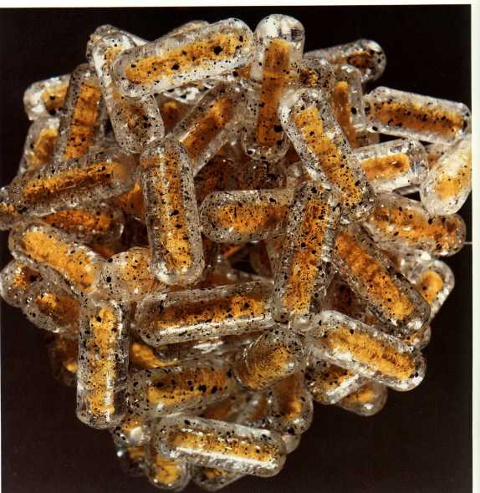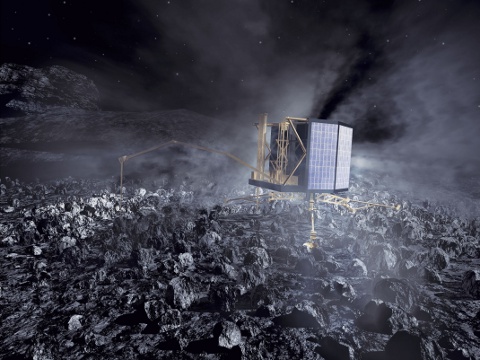
Home | Group | Research | Publications | Seminars/Workshops | Teaching | Open Positions | How to find us | Intranet
Deutsch | English

Home | Group | Research | Publications | Seminars/Workshops | Teaching | Open Positions | How to find us | Intranet
Deutsch | English
Astrochemistry studies chemical processes outside Earth. These encompass anything from the very simplest synthesis of H2 from H atoms all the way up to the generation of very large and complex polyaromatic haydrocarbons (PAHs).
In our group we study those reactions that start with simple and very abundant molecules like H2O, CO, NH3, CO2 and others which form simple organic molecules like formamide, urea, glycerol or amino acids. This prebiotic interstellar chemistry is thought to have provided the starting materials for the origin of life on our planet and possibly others.
The origin of biomolecular homochirality is of particular scientific interest. This effect describes the fact that all living things are made exclusively from L-amino acids and D-sugars. One model attempting to explain the origin of this effect is that of interstellar asymmetric photochemistry. This model claims that symmetry breaking occurred outside Earth or even outside our solar system by enantiomers’ different interaction with circularly polarized light. These interactions are studied in cooperation with the synchrotron center ASTRID in Aarhus, Denmark.

Further information:
Anisotropy Spectra of Amino Acids;
C. Meinert, J. H. Bredehöft, J.-J. Filippi, Y. Baraud, L. Nahon, F. Wien, N. C. Jones, S. V. Hoffmann, U. J. Meierhenrich,
Angewandte Chemie International Edition, vol. 51, pp. 4484-4487 (2012)
Photochirogenesis: Photochemical models on the absolute asymmetric formation of amino acids in interstellar space;
C. Meinert, P. de Marcellus, L. Le Sergeant d‘Hendecourt, L. Nahon, N. C. Jones, S. V. Hoffmann, J. H. Bredehöft, U. J. Meierhenrich,
Physics of Life Reviews, vol.8, pp.307-330 (2011)
Circular Dichroism of Amino Acids in the Vacuum-Ultraviolet Region;
U. J. Meierhenrich, J.-J. Filippi, C. Meinert, J. H. Bredehöft, J. Takahashi, L. Nahon, N. C. Jones, S. V. Hoffmann,
Angewandte Chemie International Edition, vol. 49, pp. 7799-7802 (2010)
Along with the described photochemistry, chemistry induced by slow electrons is another field of study in astrochemistry. Chemistry outside Earth mostly takes place on the surface of very cold dust grains. Whenever such a dust grain is hit by a cosmic ray, this produces a cascade of secondary electrons that in turn can initiate chemical processes in the ice layers surrounding the dust grains. These chemical processes that take place at very low pressures and temperatures are studied in our lab.

Further information:
Electron-Induced Formation of Ethyl Methyl Ether in Condensed Mixtures of Methanol and Ethylene; F. Schmidt, P. Swiderek and J. H. Bredehöft, JPC A, vol. 123, pp. 37 – 47 (2019)
Electron-Induced Hydration of an Alkene: Alternative Reaction Pathways;
J. Warneke, Z. Wang, P. Swiderek and J.H. Bredehöft,
Angewandte Chemie International Edition, vol. 54, pp. 4397 – 4400 (2015)
Electron-induced synthesis of formamide in condensed mixtures of carbon monoxide and ammonia; J.H. Bredehöft, E. Böhler, F. Schmidt, T. Borrmann, P. Swiderek, ACS Earth and Space Chemistry, vol. 1, pp. 50 – 59 (2017)
The third area of our work in astrochemistry is our involvement with ESA mission ROSETTA. ROSETTA is a space probe that will rendezvous with comet 67P/Churyumov-Gerasimenko in the summer of 2014. In November 2014 it is scheduled to set down a landing unit on the surface of the comet nucleus. On board this landing unit called Philae is, amongst others, the COSAC experiment. COSAC stands for Cometary Sampling and Compostion experiment and is a small analytical lab which can sample and analyse the compostion of both the gas phase and of ice samples taken from the comet nucleus. At its heart is an enantioselective gas chromatograph which can analyze the enantiomeric compostion of amino acids and other organic molecules found on the comet.

Further information:
Decay of COSAC and Ptolemy Mass Spectra at Comet 67P/Churyumov-Gerasimenko;
H. Krüger, F. Goesmann, C. Giri, I. Wright, A. Morse, J.H. Bredehöft, S. Ulamec, B. Cozzoni, P. Ehrenfreund, T. Gautier, S. McKenna-Lawlor, F. Raulin, H. Steininger, C. Szopa, A&A, vol. 600, A56 (2017)
Organic compounds on the nucleus of comet 67P/Churyumov-Gerasimenko as revealed by COSAC mass spectrometry;
F. Goesmann, H. Rosenbauer, J.H. Bredehöft, M. Cabane, P. Ehrenfreund, T. Gautier, C. Giri, H. Krüger, L. Le Roy, A.J. MacDermott, S. McKenna-Lawlor, U.J. Meierhenrich, G.M. Muñoz Caro, F. Raulin, R. Roll, A. Steele, H. Steininger, R. Sternberg, C. Szopa, W. Thiemann, S. Ulamec,
Science, vol. 349 no. 6247, aab0689 (2015)
COSAC prepares for sampling and in situ analysis of cometary matter from comet 67P/Churyumov–Gerasimenko;
F. Goesmann, F. Raulin, J.H. Bredehöft, M. Cabane, P. Ehrenfreund, A.J. MacDermott, S. McKenna-Lawlor, U.J. Meierhenrich, G.M. Muñoz Caro, C. Szopa, R. Sternberg, R. Roll, W.H.-P. Thiemann, S. Ulamec,
Planetary and Space Science, vol. 103, pp. 318 – 330 (2014)
Interpretation of COSAC mass spectrometer data acquired during Rosetta‘s Lutetia fly-by 10 July 2010;
F. Goesmann, S. McKenna-Lawlor, R. Roll, J.H. Bredehöft, U. Meierhenrich, F. Raulin, W. Thiemann, G.M. Muñoz Caro, C. Szopa,
Planetary and Space Science, vol. 66, pp. 187-191 (2012)